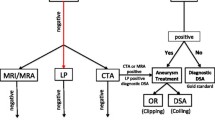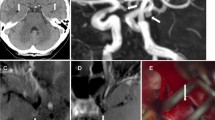Abstract
Objective
Subarachnoid hemorrhage (SAH) is a neurological condition with an annual incidence of 6–22 per 100,000. Despite many advances in diagnosis, the rates of mortality and morbidity in patients remain high. The most important reason for this is complications accompanied by perfusion changes. The aim of our study was to show the perfusion changes with arterial spin labelling (ASL) after SAH.
Materials and methods
In this prospective study, 23 patients diagnosed with aneurysmal SAH were evaluated by ASL perfusion imaging between days 1–3 and 8–10. The mean signal intensities (SI) of both hemispheres from the anterior cerebral artery, middle cerebral artery, and basal ganglia were measured manually according to the region of interest. The relationship between the SI values calculated for both cerebral hemispheres, complications, and grading scales of the side with more intense (ipsilateral) and less (contralateral) bleeding were evaluated.
Results
There was a significant difference in the ipsilateral/contralateral SI ratio (SIIps/ConBGin) (p = 0.015) among all ASL values, including the basal ganglia between days 0–3 and 8–10. There was a significant negative correlation between ASL parameters and rating scale scores. Additionally, when the SIIps/ConBGinDay0–3 ratio cut-off value was ≤ 0.72, the sensitivity and specificity were 57.1% and 100.0%, respectively, in predicting non-fatal complications, and the sensitivity and specificity in predicting all complications, including death, were 55.6% and 100.0%, respectively.
Conclusion
Global or regional perfusion decrease can be shown using ASL, with or without the development of vasospasm, without the need for exogenous contrast agent use.
Zusammenfassung
Ziel
Eine Subarachnoidalblutung (SAB) ist eine neurologische Erkrankung mit einer jährlichen Inzidenz von 6–22 pro 100.000. Trotz zahlreicher Fortschritte in der Diagnostik sind die Mortalitäts- und Morbiditätsraten bei den Patienten weiterhin hoch. Wichtigster Grund dafür sind Komplikationen, begleitet von Perfusionsänderungen. Ziel der vorliegenden Studie war es, Perfusionsänderungen mittels arterieller Spin-Labelling-Bildgebung (ASL) nach SAB darzustellen.
Material und Methoden
In dieser prospektiven Studie wurde bei 23 Patienten mit der Diagnose einer aneurysmatisch bedingten SAB eine Untersuchung mittels ASL-Perfusions-Bildgebung im Zeitraum zwischen Tag 1–3 und 8–10 durchgeführt. Dabei wurden die mittleren Signalintensitäten (SI) beider Hemisphären von der A. cerebi anterior, A. cerebi media und den Basalganglien je nach interessierender Region manuell gemessen. Der Zusammenhang zwischen den SI-Werten, berechnet für beide Hirnhemisphären, Komplikationen und Schweregradskalen der Seite mit intensiverer (ipsilateral) und weniger starker (kontralateral) Blutung wurde beurteilt.
Ergebnisse
Es bestand ein signifikanter Unterschied beim ipsilateralen/kontralateralen Signalintensitätsverhältnis (SIIps/ConBGin; p = 0,015) bei allen ASL-Werten, einschließlich der Basalganglien, zwischen Tag 0–3 und 8–10. Eine signifikante negative Korrelation fand sich zwischen ASL-Parametern und den Werten in der Beurteilungsskala. Außerdem betrug im Fall eines Grenzwerts ≤ 0,72 für das Signalintensitätsverhältnis SIIps/ConBGinDay0–3 die Sensitivität 57,1% und die Spezifität 100,0% für die Vorhersage nichttödlicher Komplikationen, und für die Vorhersage sämtlicher Komplikationen einschließlich Tod lag die Sensitivität bei 55,6% und die Spezifität bei 100,0%.
Schlussfolgerung
Mit der ASL-Bildgebung kann ein globaler oder regionaler Perfusionsabfall mit oder ohne Entwicklung eines Vasospasmus nachgewiesen werden, ohne dass ein exogenes Kontrastmittel eingesetzt werden muss.






Similar content being viewed by others
Data availability
Data are available from the authors upon reasonable request.
References
Sandvei MS, Mathiesen EB, Vatten LJ, Müller TB, Lindekleiv H, Ingebrigtsen T et al (2011) Incidence and mortality of aneurysmal subarachnoid hemorrhage in two Norwegian cohorts, 1984–2007. Neurology 77(20):1833–1839
Lovelock CE, Rinkel GJE, Rothwell PM (2010) Time trends in outcome of subarachnoid hemorrhage: Population-based study and systematic review. Neurology 74(19):1494–1501
Bederson JB, Connolly ES, Batjer HH, Dacey RG, Dion JE, Diringer MN et al (2009) Guidelines for the management of aneurysmal subarachnoid hemorrhage: A statement for healthcare professionals from a special writing group of the stroke council, American Heart Association. Stroke 40(3):994–1025
van Gijn J, Kerr RS, Rinkel GJE (2007) Subarachnoid haemorrhage. Lancet 369(9558):306–318
Labriffe M, Ter Minassian A, Pasco-Papon A, N’Guyen S, Aubé C (2015) Feasibility and validity of monitoring subarachnoid hemorrhage by a noninvasive MRI imaging perfusion technique: Pulsed Arterial Spin Labeling (PASL). J Neuroradiol 42(6):358–367. https://doi.org/10.1016/j.neurad.2015.04.001
Sanelli PC, Ougorets I, Johnson CE, Riina HA, Biondi A (2006) Using CT in the diagnosis and management of patients with cerebral vasospasm. Semin Ultrasound CT MRI 27(3):194–206
Wazni W, Farooq S, Cox J‑A, Southwood C, Rozansky G, Kodankandath TV et al (2019) Use of arterial spin-labeling in patients with aneurysmal sub-arachnoid hemorrhage. J Vasc Interv Neurol 10(3):10–14
Mills JN, Mehta V, Russin J, Amar AP, Rajamohan A, Mack WJ (2013) Advanced imaging modalities in the detection of cerebral vasospasm. Neurol Res Int 2013:415960
Hiroki O, Hiroshi M, Masahiko T, Shigeharu S (2000) Impact of cerebral microcirculatory changes on cerebral blood flow during cerebral vasospasm after aneurysmal subarachnoid hemorrhage. Stroke 31(7):1621–1627
Hattingen E, Blasel S, Dettmann E, Vatter H, Pilatus U, Seifert V et al (2008) Perfusion-weighted MRI to evaluate cerebral autoregulation in aneurysmal subarachnoid haemorrhage. Neuroradiology 50(11):929–938
Etminan N, Chang HS, Hackenberg K, De Rooij NK, Vergouwen MDI, Rinkel GJE et al (2019) Worldwide incidence of aneurysmal subarachnoid hemorrhage according to region, time period, blood pressure, and smoking prevalence in the population: a systematic review and meta-analysis. JAMA Neurol 76(5):588–597
Aoyama K, Fushimi Y, Okada T, Miyasaki A, Taki H, Shibamoto K et al (2012) Detection of symptomatic vasospasm after subarachnoid haemorrhage: initial findings from single time-point and serial measurements with arterial spin labelling. Eur Radiol 22(11):2382–2391. https://doi.org/10.1007/s00330-012-2511-5
Barbier EL, Lamalle L, Décorps M (2001) Methodology of brain perfusion imaging. J Magn Reson Imaging 13(4):496–520
Haller S, Zaharchuk G, Thomas DL, Lovblad K‑O, Barkhof F, Golay X (2016) Arterial spin labeling perfusion of the brain: emerging clinical applications. Radiology 281(2):337–356
Watts JM, Whitlow CT, Maldjian JA (2013) Clinical applications of arterial spin labeling. NMR Biomed 26(8):892–900
Kivisaari RR, Salonen O, Servo A, Autti T, Hernesniemi J, Öhman J (2001) MR imaging after aneurysmal subarachnoid hemorrhage and surgery: A long-term follow-up study. Am J Neuroradiol 22(6):1143–1148
Macdonald RL, Pluta RM, Zhang JH (2007) Cerebral vasospasm after subarachnoid hemorrhage: the emerging revolution. Nat Clin Pract Neurol 3(5):256–263. https://doi.org/10.1038/ncpneuro0490
Sotoudeh H, Shafaat O, Singhal A, Bag A (2019) Luxury perfusion: A paradoxical finding and pitfall of CT perfusion in subacute infarction of brain. Radiol Case Rep 14(1):6–9
Wintermark M, Fischbein NJ, Smith WS, Ko NU, Quist M, Dillon WP (2005) Accuracy of dynamic perfusion CT with deconvolution in detecting acute hemispheric stroke. AJNR Am J Neuroradiol 26(1):104–112
Author information
Authors and Affiliations
Contributions
Sinan Erdemi and Şükrü Oğuz were in charge of conceptualization, methodology/study design, formal analysis, supervision and project administration. Sinan Erdemi, Şükrü Oğuz and Aykut Teymur were responsible for validation. Cemal Aydoğan, Onur Bektaş, and Hatice Tayar carried out the investigation and dealt with the resources. Aykut Teymur was responsible for data curation and visualization. Zeynep Aydoğan and Elif M. Bal were responsible for writing the original draft as well as writing–review and editing of the manuscript.
Corresponding author
Ethics declarations
Conflict of interest
S. Erdemi, Ş. Oğuz, C. Aydoğan, O. Bektaş, A. Teymur, Z. Aydoğan, E.M. Bal and H. Tayar declare that they have no competing interests.
For this study approval was received from Karadeniz Technical University Clinical Research Ethics Committee with decision numbered 24237859-896 on 20.12.2019.
The supplement containing this article is not sponsored by industry.
Additional information
Publisher’s Note
Springer Nature remains neutral with regard to jurisdictional claims in published maps and institutional affiliations.

Scan QR code & read article online
Rights and permissions
About this article
Cite this article
Erdemi, S., Oğuz, Ş., Aydoğan, C. et al. Brain damage evaluation via arterial spin labeling perfusion imaging for patients with aneurysmal subarachnoid hemorrhage. Radiologie 63 (Suppl 2), 98–107 (2023). https://doi.org/10.1007/s00117-023-01228-2
Received:
Accepted:
Published:
Issue Date:
DOI: https://doi.org/10.1007/s00117-023-01228-2




